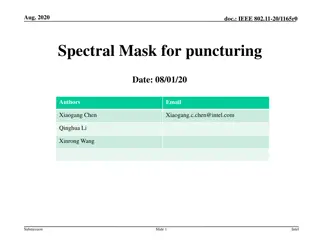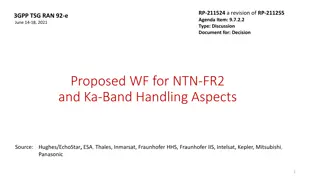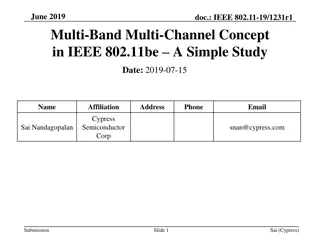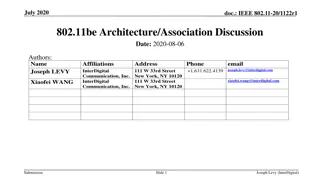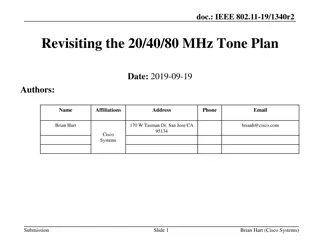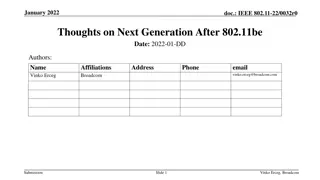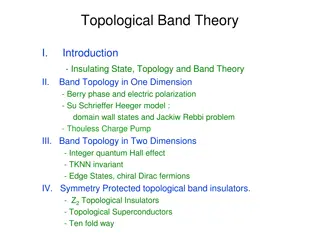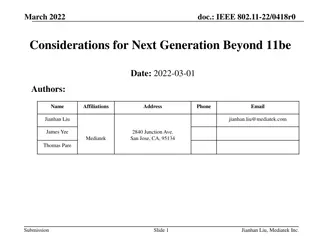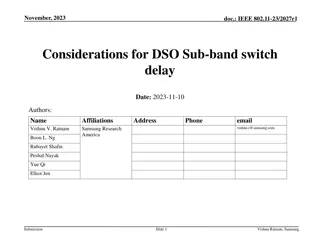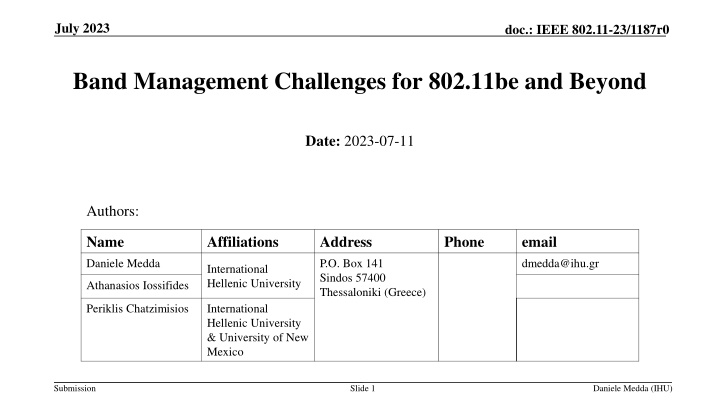
Band Management Challenges for 802.11be and Beyond
This document discusses band management challenges for IEEE 802.11be networks and beyond, focusing on band allocation policies, system models, simulation setups, trade-offs, and results obtained for access delay and throughput in mixed network environments. It addresses the impact of legacy devices and introduces Multi-Link Operation (MLO) dimensions to enhance performance.
Download Presentation

Please find below an Image/Link to download the presentation.
The content on the website is provided AS IS for your information and personal use only. It may not be sold, licensed, or shared on other websites without obtaining consent from the author. If you encounter any issues during the download, it is possible that the publisher has removed the file from their server.
You are allowed to download the files provided on this website for personal or commercial use, subject to the condition that they are used lawfully. All files are the property of their respective owners.
The content on the website is provided AS IS for your information and personal use only. It may not be sold, licensed, or shared on other websites without obtaining consent from the author.
E N D
Presentation Transcript
July 2023 doc.: IEEE 802.11-23/1187r0 Band Management Challenges for 802.11be and Beyond Date: 2023-07-11 Authors: Name Affiliations Address Phone email Daniele Medda P.O. Box 141 Sindos 57400 Thessaloniki (Greece) dmedda@ihu.gr International Hellenic University Athanasios Iossifides Periklis Chatzimisios International Hellenic University & University of New Mexico Submission Slide 1 Daniele Medda (IHU)
July 2023 doc.: IEEE 802.11-23/1187r0 Outline Introduction Band allocation policies. Employed system model and simulation setup. Obtained results for both access delay and throughput. Identified trade-offs and final remarks References Annex Submission Slide 2 Daniele Medda (IHU)
July 2023 doc.: IEEE 802.11-23/1187r0 Introduction Mixed device types We cannot ignore the presence of legacy devices. Several works proved they can impact the network performance [1][2]. Multi-Link Operation MLO introduces several new dimensions to deal with. Aim Study how the employment of different band allocation policies affect mainly the access delay performance in mixed networks Submission Slide 3 Daniele Medda (IHU)
July 2023 doc.: IEEE 802.11-23/1187r0 Study cases Legacy devices behaviour is constant for all four cases. Investigated the band allocation only for the MLDs: Access and traffic bands are handled separately: a device could use a single band for access and transmit data to additional bands if they have been idle for at least two DCF slots. Submission Slide 4 Daniele Medda (IHU)
July 2023 doc.: IEEE 802.11-23/1187r0 System model and simulation setup 30 or 50 total devices over a physical area of 15 x 15 m2. Single IEEE 802.11be enabled AP placed at the center of the area. All stations operating using RTS/CTS mechanism and in full buffer condition. Legacy devices are of IEEE 802.11ac type and are split in two bands: Ratio 1: 50%-50% 50% on 2.4 GHz, 50% on 5 GHz. Ratio 2: 75%-25% 75% on 2.4 GHz, 25% on 5 GHz. MLA-S MLDs employ MLA-S channel access methodology [3][4] Submission Slide 5 Daniele Medda (IHU)
July 2023 doc.: IEEE 802.11-23/1187r0 Simulation trials Parameter Channel BW CWmin Retry limit Payload Control frames rate Replications/point Value 80 MHz 16 7 1500 bytes 6.8 Mbps 150 Simulations carried out on a custom event- based Python simulator. Percentage of legacy devices were varied in 10% steps. MCS selection: genie fashion via lookup tables aiming for PER < 10%. Submission Slide 6 Daniele Medda (IHU)
July 2023 doc.: IEEE 802.11-23/1187r0 Obtained results: average access delay (50 devices) b) Legacies 5 c) MLDs a) Legacies 2.4 Note on Figure b: looks counter-intuitive. In fact, increasing number of legacies decreases the total devices contending for the 5 GHz band (see Annex). Submission Slide 7 Daniele Medda (IHU)
July 2023 doc.: IEEE 802.11-23/1187r0 Obtained results: average access delay (30 devices) b) Legacies 5 c) MLDs a) Legacies 2.4 Trends are identical, just shifted downwards (as expected). Submission Slide 8 Daniele Medda (IHU)
July 2023 doc.: IEEE 802.11-23/1187r0 Brief look at the system throughput (50 devices) Not a huge difference between the 50%-50% and the 75%-25% ratios. A{all}/D{all} (purple curve) indeed provides the highest throughput, but on the other hand leads to overall higher delays. Submission Slide 9 Daniele Medda (IHU)
July 2023 doc.: IEEE 802.11-23/1187r0 Identified trade-offs: final remarks Lowest access delay for legacy devices on 2.4 GHz no MLDs at all in this band. Throughput is severely affected. Lowest access delay for legacy devices on 5 GHz achieved when A{5, 6}/D{all} is used. Satisfactory throughput. Network-wise low access delay A{5,6}/D{all}. Legacy split ratio in the lower bands can be used to balance the gain (loss) of 5 and 6 GHz devices: Throughput is practically unaffected if balancing is properly done. Overall, there is a need to appropriate manage access and traffic bands to attain the desirable performance. Submission Slide 10 Daniele Medda (IHU)
July 2023 doc.: IEEE 802.11-23/1187r0 References [1] M. Carrascosa, G. Geraci, E. Knightly, and B. Bellalta, An Experimental Study of Latency for IEEE 802.11be Multi-link Operation, in ICC 2022 [2] N. Korolev, I. Levitsky, and E. Khorov, Analytical Model of Multi-link Operation in Saturated Heterogeneous Wi-Fi 7 Networks, IEEE Wireless Communications Letters, 2022. [3] 802.11-19/1546r0 Legacy Performance Impact on Multi-Link Operation [4] 802.11-20/0026r7 MLA: Sync PPDUs [5] 802.11-19/1144r6 Channel Access for Multi-link Operation Submission Slide 11 Daniele Medda (IHU)
July 2023 doc.: IEEE 802.11-23/1187r0 Annex Consider the A{5}/D{5,6} case with 50%-50% ratio (red solid curve): At 30%, 50 total devices split in: 8 legacies on 2.4 GHz; 8 legacies on 5 GHz; 34 MLDs accessing on 5 GHz; Devices contending for 5 GHz: 42. At 60%, 50 total devices split in: 15 legacies on 2.4 GHz; 15 legacies on 5 GHz; 20 MLDs accessing on 5 GHz; Devices contending for 5 GHz: 35. Submission Slide 12 Daniele Medda (IHU)





